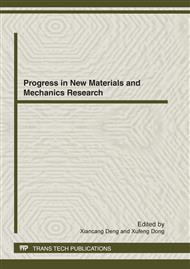[1]
HE Zhong-zhi, Electrical Steel, Metallurgical Industry Press, Beijing, 1997(in Chinese).
Google Scholar
[2]
Jong-Tae Park, Jerzy A. Szpunar, Effect of initial grain size on texture evolution and magnetic properties in nonoriented electrical steels, J Magn Magn Mater. 321 (2009) 1928–1932.
DOI: 10.1016/j.jmmm.2008.12.015
Google Scholar
[3]
REN Hui-ping, MAO Wei-ming, Precipitation behavior of B2-like particle in Fe-Cu binary alloy, J Univ Science & Technol Beijing.2002,9(3):185-187.
Google Scholar
[4]
REN Hui-ping, WANG Yu-feng, LI Wen-xue, Observation of microstructure during Cu precipitating in high purity steel, Journal of Baotou University of Iron and Steel Technology,2002,21(2):147-149.
Google Scholar
[5]
Thompson S W, Krauss G, Copper precipitation during continuous cooling and isothermal aging of A710-type steels, Metall Trans A, 27A (1996)1573-1588.
DOI: 10.1007/bf02649816
Google Scholar
[6]
Claudemiro Bolfarini, Alberto Moreira Jorge Jr, Claudio Shyinti Kiminami, et al, Mag netic properties of spray-formed Fe-6.5%Si and Fe–6.5%Si–1.0%Al after rolling and heat treatment, J Magn Magn Mater. 320 (2008) e653-e656.
DOI: 10.1016/j.jmmm.2008.04.104
Google Scholar
[7]
LIANG Yong-feng, LIN Jun-pin, YE Feng, et al, Effect of heat treatment on microstructure and magnetic properties of cold rolled Fe-6.5%Si alloy sheet, Transactions of materials and heat treatment,2009,30(2):85-88.
Google Scholar
[8]
Institut für Materialphysik, Universität Münster, Ostwald ripening of precipitates during two successive heat treatments performed at different temperatures, Acta Materialia.56 (2008) 150–154.
DOI: 10.1016/j.actamat.2007.09.024
Google Scholar
[9]
YONG Qi-long, Secondary Phases In Steels, Metallurgical Industry Press, Beijing, 2006.
Google Scholar
[10]
J. Shi, X. Wang,Comparison of Precipitate Behaviors in Ultra-Low Carbon, Titanium-Stabilized Interstitial Free Steel Sheets under Different Annealing Processes, JMEPEG.8(1999)641-648.
DOI: 10.1361/105994999770346396
Google Scholar


